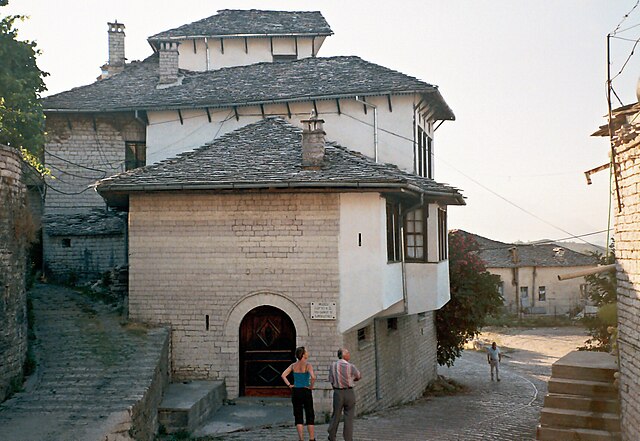热门问题
时间线
聊天
视角
吉诺卡斯特
阿尔巴尼亚吉诺卡斯特州的市镇及城市 来自维基百科,自由的百科全书
Remove ads
吉诺卡斯特(阿尔巴尼亚语:Gjirokastër)是阿尔巴尼亚南部吉诺卡斯特州的市镇及城市,为该州的州府。整个市镇面积为469.55平方公里,人口数量为28,673人(2011年)[1]。吉诺卡斯特素有“石头城”的美誉。
此条目翻译品质不佳。 |
吉诺卡斯特古城是世界文化遗产之一,于2005年入选,因为它是保护完好的奥斯曼土耳其帝国城镇,始建于公元四世纪。
它也是阿尔巴尼亚劳动党领导人恩维尔·霍查和作家伊斯梅尔·卡达莱的故乡。还是革命电影《宁死不屈》的故事发生的地方和拍摄地点。
吉诺卡斯特是阿尔巴尼亚南部的商业中心,有公路通往发罗拉港,近郊产褐煤。有机械制造、木材加工、烟草、皮革、纺织和食品等工业。有中世纪城堡、清真寺、教堂和博物馆、游览地。
Remove ads
名字及词源
该地首次以其中世纪的名字Argyrókastron(古希腊语:Αργυρόκαστρον)出现在历史文献中,是由约翰六世·坎塔库泽努斯在1336年提及的[2]。该名字意为“银色城堡”。拜占庭的文献中也使用意思相同的名字Argyropolýchni( 古希腊语:Αργυροπολύχνη)。
该地的阿尔巴尼亚语名字为Gjirokastër,故中文译名为吉罗卡斯特[3]。但其在阿尔巴尼亚语盖格方言中的名字为Gjinokastër(两者均来源于希腊语名字),新华社按照此名将该地译为吉诺卡斯特[4]。
历史
考古证据指出,在青铜时代这个地区居住着可能会说希腊西北部方言的人群。[5]考古学家在Gjirokastër发现了早期铁器时代的陶器物品,最早出现在Pazhok的青铜器时代艾巴申州,并且遍及阿尔巴尼亚。[6] Gjirokastër周围地区最早的记录居民是属于Epirote群Chaonians的希腊语部落。[7]

城市的墙壁可追溯到公元三世纪。城堡的高石墙是从第六世纪到十二世纪建造的。[8]在此期间,Gjirokastër发展成为一个主要的商业中心,被称为'Argyropolis'(古希腊语:Ἀργυρόπολις,直译:“银城”)或'Argyrokastron'(古希腊语:Ἀργυρόκαστρον,直译:“银城堡”)。[9]
这个城市是伊庇鲁斯Despotate的一部分,并于1336年首次由ArgyrokastroJohn VI Kantakouzenos提及。[10]第一次提到阿尔巴尼亚族游牧团体发生在14世纪初,他们在那里寻找新的牧场和破坏该地区的定居点。[11]These Albanians had entered the region and took advantage of the situation after the Black death had decimated the local Epirote population.[11]在1386年至1417年期间,它在伊庇鲁斯的统治者和阿尔巴尼亚约翰泽内维西的氏族之间有争议。[12]在1399年,该城市的希腊居民加入了伊庇鲁斯的暴君Esau组织,以对抗阿尔巴尼亚族和阿蒙罗族的部落成员。[13]在1417年它成为奥斯曼帝国的一部分,并于1419年成为阿尔巴尼亚Sanjak县城。[14]在阿尔巴尼亚1432-36年的起义期间,它被托皮亚·齐内维西下的部队包围,但反叛分子被图拉汉贝领导的奥斯曼军队击败。[15]在十七世纪七十年代,当地贵族曼托斯帕帕吉尼斯和帕诺斯凯斯托利科斯与神圣同盟负责人讨论了作为希腊和阿尔巴尼亚被奴役的希腊代表,约翰奥地利和其他各种欧洲统治者,反奥斯曼帝国武装斗争的可能性,但这一举措毫无结果。[16][17][18]
根据1670年访问该城市的土耳其人旅行者,当时在城堡内有200间房屋,在'KyçykVarosh'基督教东部社区有200间房屋 意思是城堡外面的小邻居),'Byjyk Varosh'(意思是城堡外的大街区)有150个房屋,还有另外6个社区:Palorto、Vutosh、Dunavat、Manalat、Haxhi Bey及Memi Bey,城堡周围的山丘。[19]据旅行者说,当时该市有大约2000座房屋,8座清真寺,3座教堂,280间商店,5个喷泉和5个旅馆。[19]从十六世纪到十九世纪初,吉诺卡斯特从一个主要的基督教城市变成了一个拥有大多数穆斯林教徒的城市,这是由于大部分城市人口皈依伊斯兰教以及来自周边农村的穆斯林皈依者。[20][21]
Remove ads

1811年,吉诺卡斯特成为了阿尼娜的Pashalik的一部分,然后由阿尔巴尼亚出生的约阿尼纳的阿里帕夏领导,并在1822年被改造成巴尔干半岛西南部的一个半自治的地方,直到他去世为止。1868年被帕夏克人沦陷后,这座城市是埃尔吉里sanjak的首府。 1880年7月23日,阿尔巴尼亚南部[普里兹伦联盟]委员会在该市举行了一次大会,决定如果奥斯曼帝国的阿尔巴尼亚人口居住区被割让给邻国,他们就会起而反抗。[22]在阿尔巴尼亚民族觉醒运动(1831-1912)期间,该城市是该运动的主要中心,据报这一时期该城市的一些团体设立阿尔巴尼亚民族英雄斯坎德培的肖像。[23]从十九世纪中期开始吉诺卡斯特也通过担任“卡迪”(公务员)并且是伊斯兰文化的重要中心的个人对更广泛的奥斯曼帝国作出了显著贡献。[24]1909 - 1912年这座城市的亲阿尔巴尼亚族分裂为两个群体:希望与希腊人合作的城市自由派和在乡下组织游击队的阿族民族主义者。[21]在十九世纪和二十世纪初,说阿尔巴尼亚语的穆斯林是吉诺卡斯特的主要居民,而只有少数说希腊语的家庭居住在那里。[21]
考虑到其庞大的希腊人口,这座城市在1912年至1913年的第一次巴尔干战争期间被希腊人宣布和占领,随后奥斯曼土耳其人从该地区撤退。[25]但是,根据1913年伦敦条约和佛罗伦萨议定书12月17日的条款,该项目被授予阿尔巴尼亚1913年独立。[26]
这一事件证明,当地希腊人民非常不受欢迎,他们在Georgios Christakis-Zografos下的代表在吉诺卡斯特组成了Panepirotic议会,抗议希腊人留在吉诺卡斯特生活。[27]大会与希腊合并之后,要求大国的部队对吉诺卡斯特,萨兰达和科尔察的地区实行地方自治或国际占领。[28]

1914年3月,吉诺卡斯特宣布了北伊庇鲁斯独立宣言,并在科孚协议中得到确认。[29]然而,共和国却很短暂,因为阿尔巴尼亚在第一次世界大战开始时就崩溃了。[30]希腊军队于1914年10月至11月返回,并再次与萨兰达和科尔察一起占领了吉诺卡斯特。[31]1916年4月,希腊人称为北方伊庇鲁斯的领土,包括吉诺卡斯特,被并入希腊。[31]巴黎和会签署后恢复了战前的状况,基本上维持了1913年佛罗伦萨议定书中确定的边界线,该城市又被归还到阿尔巴尼亚人的控制之下。[32]
随着城市在阿尔巴尼亚公国的纳入,希腊人被剥夺了少数人的权利。 尽管如此,吉诺卡斯特作为一个多民族城市仍然保留着希腊文字。[33] 1939年4月,在意大利入侵阿尔巴尼亚之后,吉诺卡斯特被意大利占领。1940年12月8日,希腊战争期间,希腊军队进入城市并停留了五个月,随后于1941年4月向纳粹德国投降,并将该城重新归为意大利司令部。1943年9月意大利在卡西比尔停战投降后,该城被德军占领,并于1944年最终返回阿尔巴尼亚控制。
二战后,阿尔巴尼亚社会主义人民共和国将这个城市发展成为工业和商业中心。同时,作为领导人恩维尔·霍查的诞生地,它还被提升到博物馆城市的地位。恩维尔·霍查居住过的房子也被改建成博物馆。[34]
1991年8月阿尔巴尼亚政局变迁期间,当地希腊社区成员拆除了恩维尔·霍查在吉诺卡斯特的巨大雕像。[35]此后吉诺卡斯特遭受了严重的经济问题。1993年春季,吉诺卡斯特尔地区成为希腊少数民族成员和阿尔巴尼亚警察之间冲突的中心。[36]吉诺卡斯特特别受到1997年阿尔巴尼亚危机战争的大规模非法传销计划崩溃影响,这使整个阿尔巴尼亚经济不稳定。这座城市成为反对萨利·贝里沙政府叛乱的焦点,暴力反政府抗议活动发生,最终迫使贝里沙辞职下台。1997年12月16日,霍查的故居被不明身份的袭击者破坏,但后来又恢复原状。[37]
Remove ads
地理
吉诺卡斯特位于阿尔巴尼亚西南部内陆盆地。现今的吉诺卡斯特市镇是在2015年地方政府改革时由原7个市镇合并而成立的,原7个市镇则成为新市镇下属的行政分区。新市镇的行政中心为吉诺卡斯特城[38]。整个市镇的面积为469.55平方公里,人口数量为28,673人(2011年)[39]。吉诺卡斯特城的人口数量则为19,836人(2011年)[40]。
吉诺卡斯特位于阿尔巴尼亚西南部的低地和内陆高地之间,因此有一个炎热干燥的夏季和寒冷多雨的冬季,吉诺卡斯特属于地中海气候(这对阿尔巴尼亚来说是正常的),而吉诺卡斯特的降雨量比阿尔巴尼亚其他地中海气候城市来说要多。
Remove ads
人物
相册
-
时钟楼
-
咖啡街
-
被遗弃的美军飞机
参考资料
外部链接
Wikiwand - on
Seamless Wikipedia browsing. On steroids.
Remove ads






